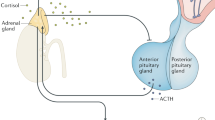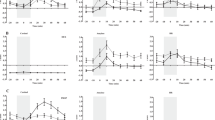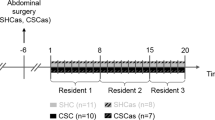Abstract
Routine laboratory procedures, such as handling or transporting animals or carrying out injections on animals, are stressful for animals but are necessary in many pre-clinical studies. Here, the authors show that multiple injections of the non-toxic vehicle cyclodextrin moderately increased plasma corticosterone concentrations in female BALB/c mice. Additionally, male BALB/c mice that had received a single intraperitoneal injection of harmless saline had an increased glucocorticoid response to a second saline injection. The authors found that female mice that had been exposed to an acute psychological stress session had a decreased glucocorticoid response to a second homotypic stressor. In contrast, multiple psychological stress sessions led to increased glucocorticoid release in female mice. Acute injection(s) of saline in male mice and of cyclodextrin in female mice led to transient lymphocytopenia. Further analysis showed that repeated stress–induced lymphocytopenia is glucocorticoid-dependent. The authors conclude that laboratory stress can affect physiological parameters in mice, potentially altering study results.
This is a preview of subscription content, access via your institution
Access options
Subscribe to this journal
We are sorry, but there is no personal subscription option available for your country.
Buy this article
- Purchase on Springer Link
- Instant access to full article PDF
Prices may be subject to local taxes which are calculated during checkout






Similar content being viewed by others
References
Castelhano-Carlos, M.J. & Baumans, V. The impact of light, noise, cage cleaning and in-house transport on welfare and stress of laboratory rats. Lab Anim. 43, 311–327 (2009).
Arndt, S.S. et al. Individual housing of mice—impact on behaviour and stress responses. Physiol. Behav. 97, 385–393 (2009).
McEwen, B.S. The brain is the central organ of stress and adaptation. Neuroimage 47, 911–913 (2009).
Armario, A., Hernández, J., Bluethmann, H. & Hidalgo, J. IL-6 deficiency leads to increased emotionality in mice: evidence in transgenic mice carrying a null mutation for IL-6. J. Neuroimmunol. 92, 160–169 (1998).
Armario, A., Martí, O., Vallès, A., Dal-Zotto, S. & Ons, S. Long-term effects of a single exposure to immobilization on the hypothalamic-pituitary-adrenal axis: neurobiologic mechanisms. Ann. NY Acad. Sci. 1018, 162–172 (2004).
Armario, A., Escorihuela, R.M. & Nadal, R. Long-term neuroendocrine and behavioural effects of a single exposure to stress in adult animals. Neurosci. Biobehav. Rev. 32, 1121–1135 (2008).
Fernandes, G.A. et al. Habituation and cross-sensitization of stress-induced hypothalamic-pituitary-adrenal activity: effect of lesions in the paraventricular nucleus of the thalamus or bed nuclei of the stria terminalis. J. Neuroendocrinol. 14, 593–602 (2002).
Spiga, F. et al. Effect of vasopressin 1b receptor blockade on the hypothalamic-pituitary-adrenal response of chronically stressed rats to a heterotypic stressor. J. Endocrinol. 200, 285–291 (2009).
Kiank, C. et al. Stress susceptibility predicts the severity of immune depression and the failure to combat bacterial infections in chronically stressed mice. Brain Behav. Immun. 20, 359–368 (2006).
Kiank, C., Daeschlein, G. & Schuett, C. Pneumonia as a long-term consequence of chronic psychological stress in BALB/c mice. Brain Behav. Immun. 22, 1173–1177 (2008).
Kiank, C., Mundt, A. & Schuett, C. Mild postnatal separation stress reduces repeated stress-induced immunosuppression in adult BALB/c mice. Neuro. Endocrinol. Lett. 30, 761–768 (2009).
Depke, M. et al. Hypermetabolic syndrome as a consequence of repeated psychological stress in mice. Endocrinology 149, 2714–2723 (2008).
Depke, M. et al. Altered hepatic mRNA expression of immune response and apoptosis-associated genes after acute and chronic psychological stress in mice. Mol. Immunol. 46, 3018–3028 (2009).
Kiank, C. et al. Seasonal variations in inflammatory responses to sepsis and stress in mice. Crit. Care Med. 35, 2352–2358 (2007).
Balcombe, J.P., Barnard, N.D. & Sandusky, C. Laboratory routines cause animal stress. Contemp. Top. Lab. Anim. Sci. 43, 42–51 (2004).
Gartner, K. et al. Stress response of rats to handling and experimental procedures. Lab. Anim. 14, 267–274 (1980).
Labruto, F., Vaage, J., Li, G. & Valen, G. Intraperitoneal injection induces a delayed preconditioning-like effect in mice. Lab Anim. 39, 298–307 (2005).
Moynihan, J.A., Brenner, G.J., Ader, R. & Cohen, N. The effects of handling adult mice on immunologically relevant processes. Ann. NY Acad. Sci. 650, 262–267 (1992).
Swaim, L.D., Taylor, H.W. & Jersey, G.C. The effect of handling techniques on serum ALT activity in mice. J. Appl. Toxicol. 5, 160–162 (1985).
Besch, E.L., Chou, B.J. & Cornelius, C.E. Physiological responses to blood collection methods in rats. Proc. Soc. Exp. Biol. Med. 138, 1019–1021 (1971).
Olfe, J., Domanska, G., Schuett, C. & Kiank, C. Different stress-related phenotypes of BALB/c mice from in-house or vendor: alterations of the sympathetic and HPA axis responsiveness. BMC Physiol. 10, 2 (2010).
Gadek-Michalska, A. & Bugajski, J. Repeated handling, restraint, or chronic crowding impair the hypothalamic-pituitary-adrenocortical response to acute restraint stress. J. Physiol. Pharmacol. 54, 449–459 (2003).
Garcia, A., Marti, O., Valles, A., Dal-Zotto, S. & Armario, A. Recovery of the hypothalamic-pituitary-adrenal response to stress. Effect of stress intensity, stress duration and previous stress exposure. Neuroendocrinology 72, 114–125 (2000).
Bugajski, J., Gadek-Michalska, A. & Bugajski, A.J. A single corticosterone pretreatment inhibits the hypothalamic-pituitary-adrenal responses to adrenergic and cholinergic stimulation. J. Physiol. Pharmacol. 52, 313–324 (2001).
Girotti, M. et al. Habituation to repeated restraint stress is associated with lack of stress-induced c-fos expression in primary sensory processing areas of the rat brain. Neuroscience 138, 1067–1081 (2006).
Ma, X.M. & Lightman, S.L. The arginine vasopressin and corticotrophin-releasing hormone gene transcription responses to varied frequencies of repeated stress in rats. J. Physiol. 510, 605–614 (1998).
Jaferi, A. & Bhatnagar, S. Corticosterone can act at the posterior paraventricular thalamus to inhibit hypothalamic-pituitary-adrenal activity in animals that habituate to repeated stress. Endocrinology. 147, 4917–4930 (2006).
O'Connor, K.A. et al. Stress-induced sensitization of the hypothalamic-pituitary adrenal axis is associated with alterations of hypothalamic and pituitary gene expression. Neuroendocrinology 80, 252–263 (2004).
Márquez, C., Belda, X. & Armario, A. Post-stress recovery of pituitary-adrenal hormones and glucose, but not the response during exposure to the stressor, is a marker of stress intensity in highly stressful situations. Brain Res. 926, 181–185 (2002).
Felmet, K.A., Hall, M.W., Clark, R.S., Jaffe, R. & Carcillo, J.A. Prolonged lymphopenia, lymphoid depletion, and hypoprolactinemia in children with nosocomial sepsis and multiple organ failure. J. Immunol. 174, 3765–3772 (2005).
Krüger, K., Lechtermann, A., Fobker, M., Völker, K. & Mooren, F.C. Exercise-induced redistribution of T lymphocytes is regulated by adrenergic mechanisms. Brain Behav. Immun. 22, 324–338 (2008).
Mignini, F., Traini, E., Tomassoni, D., Vitali, M. & Streccioni, V. Leucocyte subset redistribution in a human model of physical stress. Clin. Exp. Hypertens. 30, 720–731 (2008).
Okutsu, M., Ishii, K., Niu, K.J. & Nagatomi, R. Cortisol-induced CXCR4 augmentation mobilizes T lymphocytes after acute physical stress. Am. J. Physiol. Integr. Comp. Physiol. 288, R591–R599 (2005).
Redwine, L., Snow, S., Mills, P. & Irwin, M. Acute psychological stress: effects on chemotaxis and cellular adhesion molecule expression. Psychosom. Med. 65, 598–603 (2003).
Shinkai, S., Watanabe, S., Asai, H. & Shek, P.N. Cortisol response to exercise and post-exercise suppression of blood lymphocyte subset counts. Int. J. Sports Med. 17, 597–603 (1996).
Urra, X., Cervera, A., Villamor, N., Planas, A.M. & Chamorro, A. Harms and benefits of lymphocyte subpopulations in patients with acute stroke. Neuroscience 158, 1174–1183 (2009).
Bartolomucci, A. Social stress, immune functions and disease in rodents. Front. Neuroendocrinol. 28, 28–49 (2007).
Bilbo, S.D. et al. Short day lengths augment stress-induced leukocyte trafficking and stress-induced enhancement of skin immune function. Proc. Natl. Acad. Sci. USA 99, 4067–4072 (2002).
Viswanathan, K. & Dhabhar, F.S. Stress-induced enhancement of leukocyte trafficking into sites of surgery or immune activation. Proc. Natl. Acad. Sci. USA 102, 5808–5813 (2005).
Herold, M.J., McPherson, K.G. & Reichardt, H.M. Glucocorticoids in T cell apoptosis and function. Cell. Mol. Life Sci. 63, 60–72 (2006).
Acknowledgements
The work was supported by the Deutsche Forschungsgemeinschaft (DFG, GRK-840, projects B1, C1), the Fonds der Chemischen Industrie (C.S.) and the Alfried Krupp von Bohlen and Halbach Stiftung, Essen, Germany (C.S.).
Author information
Authors and Affiliations
Corresponding author
Ethics declarations
Competing interests
The authors declare no competing financial interests.
Rights and permissions
About this article
Cite this article
Drude, S., Geißler, A., Olfe, J. et al. Side effects of control treatment can conceal experimental data when studying stress responses to injection and psychological stress in mice. Lab Anim 40, 119–128 (2011). https://doi.org/10.1038/laban0411-119
Received:
Accepted:
Published:
Issue Date:
DOI: https://doi.org/10.1038/laban0411-119



